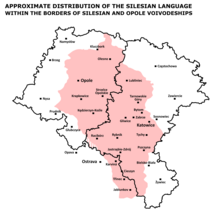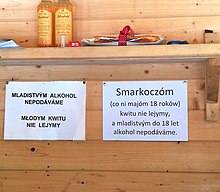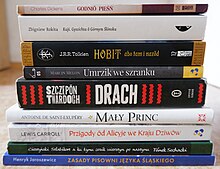
Polish is a West Slavic language of the Lechitic group within the Indo-European language family written in the Latin script. It is spoken primarily in Poland and serves as the native language of the Poles. In addition to being the official language of Poland, it is also used by the Polish diaspora. In 2023, there were over 40.6 million Polish native speakers. It ranks as the sixth most-spoken among languages of the European Union. Polish is subdivided into regional dialects and maintains strict T–V distinction pronouns, honorifics, and various forms of formalities when addressing individuals.

Silesians is a geographical term for the inhabitants of Silesia, a historical region in Central Europe divided by the current national boundaries of Poland, Germany, and the Czech Republic. Historically, the region of Silesia has been inhabited by Polish, Czechs, and by Germans. Therefore, the term Silesian can refer to anyone of these ethnic groups. However, in 1945, great demographic changes occurred in the region as a result of the Potsdam Agreement leaving most of the region ethnically Polish and/or Slavic Upper Silesian. The Silesian dialect is one of the main dialects of the Polish language and based on Polish/Lechitic grammar. The names of Silesia in different languages most likely share their etymology—Polish: ; German: Schlesienpronounced[ˈʃleːzi̯ən] ; Czech: Slezsko ; Lower Silesian: Schläsing; Silesian: Ślōnsk ; Lower Sorbian: Šlazyńska ; Upper Sorbian: Šleska ; Latin, Spanish and English: Silesia; French: Silésie; Dutch: Silezië; Italian: Slesia; Slovak: Sliezsko; Kashubian: Sląsk. The names all relate to the name of a river and mountain in mid-southern Silesia, which served as a place of cult for pagans before Christianization.

The Cieszyn Silesian dialect or Teschen Silesian dialect is one of the Silesian dialects. It has its roots mainly in Old Polish and also has strong influences from Czech and German and, to a lesser extent, from Vlach and Slovak. It is spoken in Cieszyn Silesia, a region on both sides of the Polish-Czech border. It remains mostly a spoken language. The dialect is better preserved today than traditional dialects of many other West Slavic regions.

Zebrzydowice is a village and the seat of Gmina Zebrzydowice, Cieszyn County in Silesian Voivodeship, southern Poland, near the border with the Czech Republic. It lies in the historical region of Cieszyn Silesia, on the Piotrówka River. There is a rail border crossing in the village.
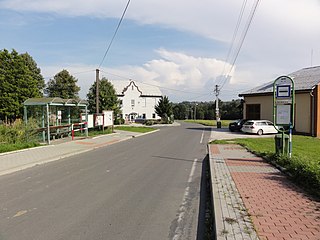
is a village in Karviná District, Moravian-Silesian Region, Czech Republic. It was a separate municipality but became administratively a part of the city of Havířov in 1974. It had a population of 576 in 2020. The village lies in the historical region of Cieszyn Silesia.

Závada is a village and administrative part of Petrovice u Karviné in Karviná District, Moravian-Silesian Region, Czech Republic.

Marklowice Górne is a village in Gmina Zebrzydowice, Cieszyn County, Silesian Voivodeship, southern Poland. Piotrówka River flows through the village.

is a village in Karviná District, Moravian-Silesian Region, Czech Republic. It was a separate municipality but became administratively a part of Orlová in 1946 and now is one of the parts of the town. It has a population of 5,604.

is a village in Frýdek-Místek District, Moravian-Silesian Region, Czech Republic. It was a separate municipality but became administratively a part of Třinec in 1980. It has a population of 1,531 and lies in the historical region of Cieszyn Silesia.
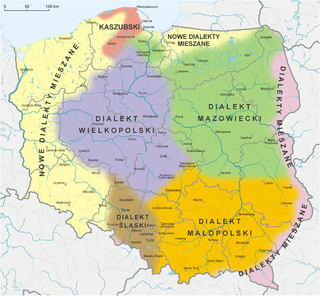
Polish dialects are regional vernacular varieties of the Polish language.

Łazy is a village in Gmina Jasienica, Bielsko County, Silesian Voivodeship, southern Poland. It lies in the Silesian Foothills and in the historical region of Cieszyn Silesia.
The Silesian tribes is a term used to refer to tribes, or groups of West Slavs that lived in the territories of Silesia in the Early Middle Ages. The territory they lived on became part of Great Moravia in 875 and later, in 990, the first Polish state created by duke Mieszko I and then expanded by king Boleslaw I at the beginning of the 11th century. They are usually treated as part of the Polish tribes and sometimes as part of the Germanic tribes. Two tribes among them are sometimes considered as Czech (Moravian) tribes.

The Silesian Wikipedia is the Silesian edition of Wikipedia. It was started on 26 May 2008.

Tomasz Kamusella is a Polish scholar pursuing interdisciplinary research in language politics, nationalism, and ethnicity.
Silesian National Publishing House is the first-ever publishing house specializing in producing books in the Silesian language and on all matters (Upper) Silesian. It was founded in 2003 in Zabrze, Poland, where it is registered under the Polish name, Narodowa Oficyna Śląska. Its owner and founder, Andrzej Roczniok was the initiator of to the codification of the Silesian language, and remains the main contributor to this process. He also applied for an ISO 639-3 code for Silesian, which was granted as szl in 2007. In the same year the Ślōnsko Nacyjno Ôficyno began publishing the first-ever periodical in Silesian and Polish, Ślůnsko Nacyjo. The publishing house's bestseller has been Dariusz Jerczyński’s extensive monograph, Historia Narodu Śląskiego, which actually commenced the publishing activities of the Ślōnsko Nacyjno Ôficyno.

The Union of Upper Silesians was an early 20th-century movement for the independence of Upper Silesia. The movement had its genesis during the revolutions of 1848. Allied with the Silesian People's Party, it dissolved in 1924 but has influenced the present-day Silesian Autonomy Movement.

Józef Kożdoń was Silesian autonomist politician.
The Silesian People’s Party was a political organization in Cieszyn Silesia that existed from 1909 to 1938 in Austrian Silesia, which later became international plebiscite territory and finally part of Czechoslovakia. The party included mainly Slavic people, who saw themselves as members of a Silesian nation. The party is seen as part of the Szlonzakian movement or Silesian Separatist Movement.

Prstná is a village in Karviná District, Moravian-Silesian Region, Czech Republic. It was a separate municipality but became administratively a part of Petrovice u Karviné in 1952.

The Silesian Separatist Movement is a minor Silesian party that advocates for Silesian independence from Poland. The party was founded on 19 March 2007 by Silesian activists Dariusz Jerczyński, Grzegorz Kot and Marcela Tampa. The party is affiliated with a Silesian regionalist organisation People of the Silesian Nation and the Silesian Autonomy Movement, and Grzegorz Kot ran for the Senate of Poland in the 2007 Polish parliamentary election on behalf of this party. Silesian Separatist Movement lists "national and territorial separation of Silesia from Poland" and "the sanctioning of Silesian nationality" as its main goals. According to its program, the party is dedicated to the concept of an independent Silesian state in tradition of interwar Silesian movements such as Silesian People's Party (1908-1938) and the Union of Upper Silesians (1919-1924), which wanted to realise this concept.

